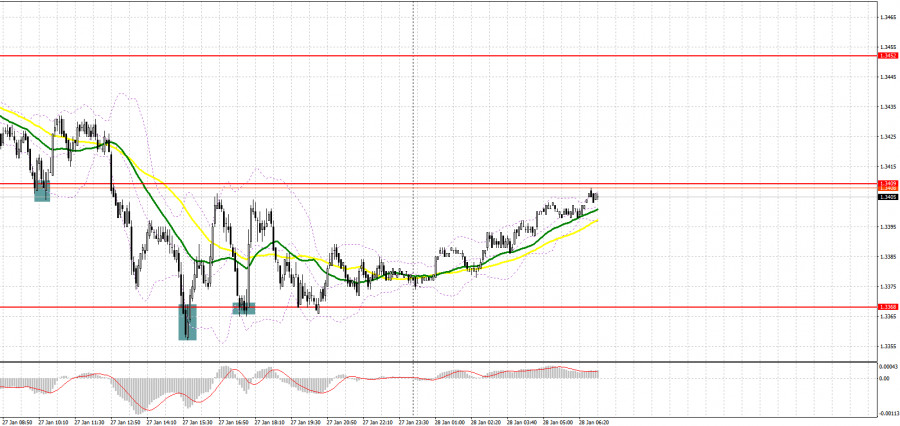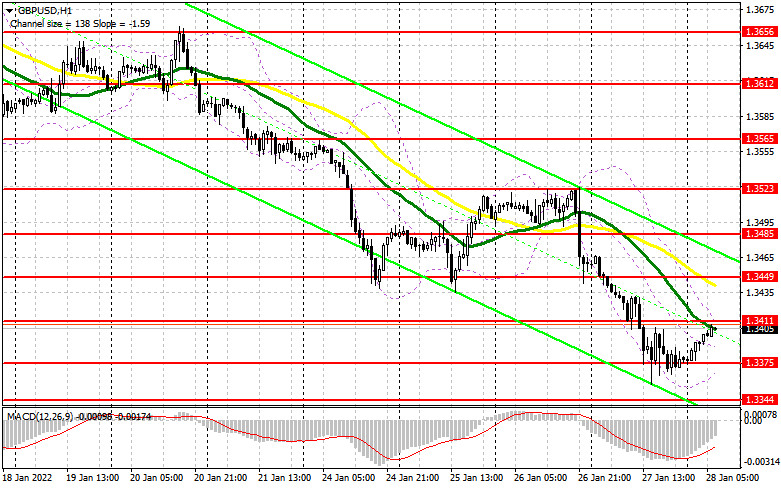
To open long positions on GBP/USD, you need:
Yesterday was quite a profitable day for trading the British pound. Let's take a look at the 5-minute chart and see what happened. In my morning forecast, I paid attention to the level of 1.3409 and advised you to make decisions on entering the market from it. Given that the bears were in full control of the situation after the Federal Reserve meeting, it was difficult to count on the bulls in the first half of the day. A false breakout at 1.3409 gave an excellent signal to buy the pound, but after a 20-point increase, the initiative quickly dried up. The repeated test of 1.3409 provided a breakthrough of this level and a further fall of the pair. I couldn't wait for the reverse test from the bottom up of the 1.3409 level, so there were no sell signals formed. However, in the afternoon, it was possible to observe false breakouts at the level of 1.3368 several times, which resulted in forming good signals to buy the pound with an upward movement of 35-40 points within the day.

Strong data on US GDP for the fourth quarter increased the pressure on the pound in the afternoon, however, the bulls promised to protect the support of 1.3365, preserving the chances of an upward correction of the pair at the end of the week. Today there are no important statistics for the UK, which rather plays into the bulls' hands, who are already aiming for a breakthrough of 1.3411. However, a much more important task for today is to protect the support of 1.3375, to which the pair may collapse at any moment, since the trend remains downward. Given that the market is bearish, it is unlikely that anything will prevent us from testing this range today. Therefore, it is so important to form a false breakout at 1.3375. Only this creates the first entry point into long trend positions. An equally important task will be a breakthrough and a test of 1.3411 from top to bottom, which will provide another entry point into long positions in order to return to 1.3449, where the moving averages are playing on the bears' side. A more difficult task is to update the 1.3485 area, which will be possible only in case of very weak statistics for the US in the afternoon. I recommend taking profits there.
In case GBP/USD falls during the European session and a lack of activity at 1.3375, and judging by the way bulls behave in the market, most likely, it will be so - it is better not to rush with purchases of risky assets. I advise you to wait for the test of the next major level of 1.3344 and forming a false breakout there will provide an entry point to long positions. You can buy the pound immediately on a rebound from 1.3322, or even lower - from a low of 1.3301, counting on a correction of 20-25 points within the day.
To open short positions on GBP/USD, you need:
Bears continue to control the market and until they update the weekly lows, it will be impractical to talk about grasping the low.
The primary task is to protect the 1.3411 level, just above which the moving averages are playing on the bears' side and limiting the upward potential of the pair. Forming a false breakout in this range creates the first entry point into short positions, counting on the continuation of the bear market and a decline in the area of intermediate support at 1.3375, formed by yesterday's results. A breakthrough and a test of 1.33875 from the bottom up will provide another entry point for short positions with the goal of pushing the pound to 1.3344 and 1.3322, where I recommend taking profits.

If the pair grows during the European session and bears are weak at 1.3411, and you need to understand that the lower the pound is, the more attractive it is for major players – the Bank of England will definitely raise interest rates at its next meeting - so it is best to postpone short positions until the next major resistance at 1.3449, where the moving averages are playing on the bears' side. I also advise you to open short positions there only in case of a false breakout. You can sell GBP/USD immediately for a rebound from 1.3485, or even higher - from this month's high in the area of 1.3523, counting on the pair's rebound down by 20-25 points within the day.
I recommend for review:
According to the Commitment of Traders (COT) report from January 18, traders increased long positions and cut on short positions. It means that the sterling retains the speculative interest after the Bank of England raised the key policy rate at the end of the last year. Currently, traders have high expectations that the regulator could increase interest rates again by 0.25% at the nearest policy meeting. Such expectations are bullish for the pound sterling.
At the same time, the fundamental picture contains some factors that cap the pound's upside potential. First, soaring inflation that has been raging for almost half a year negates strong employment in the UK. Despite high wages and a decline in the jobless rate, rampant inflation erases households' incomes. Besides, elevated energy prices and costly services make a dent in the people's well-being so that living standards are currently below the ones during the COVID pandemic. By and large, the outlook for the pound is bright. Moreover, the ongoing downward correction makes it more attractive. The Bank of England's intention to continue rate hikes this year will push the pound to new highs.
This week, traders are anticipating the crucial event: the FOMC policy meeting. The policymakers are widely expected to clear up the timeline for monetary tightening. Some analysts assume that the US central bank could decide in favor of raising interest rates at this policy meeting in January without delaying this question until March. The rate-setting committee is likely to announce tapering the Fed's balance sheet.
The COT report from January 18 reads that the number of non-commercial positions rose from 30,506 to 39,760 whereas the number of short non-commercial positions decreased from 59,672 to 40,007. This leads to a change in negative non-commercial net positions from -29,166 to -247. GBP/USD closed at 1.3647, higher than 1.3570 a week ago.
Indicator signals:
Trading is conducted below the 30 and 50 moving averages, which indicates the continuation of the bear market.
Moving averages
Note: The period and prices of moving averages are considered by the author on the H1 hourly chart and differs from the general definition of the classic daily moving averages on the daily D1 chart.
Bollinger Bands
Crossing the upper limit of the indicator in the area of 1.3411 will lead to an increase in the pound. A break of the lower limit in the area of 1.3370 will increase the pressure on the pair.
Description of indicators
Moving average (moving average, determines the current trend by smoothing out volatility and noise). Period 50. It is marked in yellow on the chart.Moving average (moving average, determines the current trend by smoothing out volatility and noise). Period 30. It is marked in green on the chart.MACD indicator (Moving Average Convergence/Divergence — convergence/divergence of moving averages) Quick EMA period 12. Slow EMA period to 26. SMA period 9Bollinger Bands (Bollinger Bands). Period 20 Non-commercial speculative traders, such as individual traders, hedge funds, and large institutions that use the futures market for speculative purposes and meet certain requirements.Long non-commercial positions represent the total long open position of non-commercial traders.Short non-commercial positions represent the total short open position of non-commercial traders.Total non-commercial net position is the difference between short and long positions of non-commercial traders.